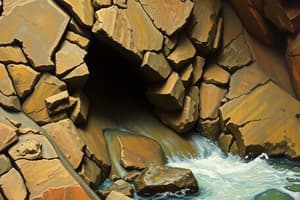Podcast
Questions and Answers
What are the 4 types of sedimentary rocks?
What are the 4 types of sedimentary rocks?
- Igneous
- Chemical (correct)
- Clastic (correct)
- Biochemical (Biogenic) (correct)
What are clastic sedimentary rocks composed of?
What are clastic sedimentary rocks composed of?
Silicate minerals and rock fragments that were transported and deposited.
What do clastic rocks typically contain?
What do clastic rocks typically contain?
Quartz, feldspar, lithic fragments, clay minerals, and mica.
What does lithic fragments mean?
What does lithic fragments mean?
How are clastic sedimentary rocks described and classified?
How are clastic sedimentary rocks described and classified?
What grain size scale is primarily used for describing clastic sedimentary rocks?
What grain size scale is primarily used for describing clastic sedimentary rocks?
What are the three grain size factions for unconsolidated sediment?
What are the three grain size factions for unconsolidated sediment?
What size is gravel?
What size is gravel?
What size is sand?
What size is sand?
What are the two types of mud?
What are the two types of mud?
What size is clay?
What size is clay?
What size is silt?
What size is silt?
What are conglomerates/breccias made of?
What are conglomerates/breccias made of?
What are sandstones made of?
What are sandstones made of?
What are mudstones/claystones mostly made of?
What are mudstones/claystones mostly made of?
What are conglomerates composed of?
What are conglomerates composed of?
What are breccias made of?
What are breccias made of?
What is the most common sandstone classification scheme?
What is the most common sandstone classification scheme?
How do you determine the first word in a sandstone name?
How do you determine the first word in a sandstone name?
Quartz sandstones have ___ quartz grains?
Quartz sandstones have ___ quartz grains?
Feldspathic sandstones have ___ quartz grains and more ___ grains than ___ grains.
Feldspathic sandstones have ___ quartz grains and more ___ grains than ___ grains.
Lithic sandstones have ___ quartz grains and more ___ grains than ___ grains.
Lithic sandstones have ___ quartz grains and more ___ grains than ___ grains.
What is a clean sandstone?
What is a clean sandstone?
What are arenites?
What are arenites?
What are wackes?
What are wackes?
What are mudstones?
What are mudstones?
Siltstones are mainly composed of ___ and with grain size from ___ to ___.
Siltstones are mainly composed of ___ and with grain size from ___ to ___.
Mudstones are mainly composed of ___.
Mudstones are mainly composed of ___.
Claystones are mainly composed of ___ and with grain size less than ___.
Claystones are mainly composed of ___ and with grain size less than ___.
What is detritus?
What is detritus?
What are the most common minerals found in detrital rocks?
What are the most common minerals found in detrital rocks?
How are detrital sedimentary rocks classified?
How are detrital sedimentary rocks classified?
How are chemical sedimentary rocks formed?
How are chemical sedimentary rocks formed?
Precipitation in chemical rocks is driven by ___ and ___.
Precipitation in chemical rocks is driven by ___ and ___.
Are chemical sedimentary rocks organic or inorganic?
Are chemical sedimentary rocks organic or inorganic?
What are some common types of chemical sedimentary rocks?
What are some common types of chemical sedimentary rocks?
How are chemical sedimentary rocks classified?
How are chemical sedimentary rocks classified?
How are biochemical sedimentary rocks created?
How are biochemical sedimentary rocks created?
Flashcards are hidden until you start studying
Study Notes
Sedimentary Rocks Overview
- Four types: Clastic, biochemical (biogenic), chemical, and other.
Clastic Sedimentary Rocks
- Composed of silicate minerals and rock fragments transported and deposited.
- Typical components: quartz, feldspar, lithic fragments, clay minerals, and mica.
- Described and classified by dominant grain size.
- Udeen-Wentworth grain size scale is commonly used.
Grain Size Classification
- Three factions for unconsolidated sediment: gravel, sand, and mud.
- Gravel: greater than 2mm diameter.
- Sand: between 0.0625 mm (1/16) and 2 mm diameter.
- Mud: composed of clay and silt.
- Clay: less than 1/256 mm; Silt: between 1/16 mm and 1/256 mm.
Types of Clastic Rock
- Conglomerates/breccias: mostly gravel, where conglomerates are rounded and breccias are angular.
- Sandstones: primarily sand.
- Mudstones/claystones: composed of mud/clay.
Sandstone Classification
- Most common classification scheme focuses on relative abundance of quartz, feldspar, and lithic fragments.
- First word in sandstone name determined by the relative abundance of sand-sized framework grains.
- Quartz sandstones: greater than 90% quartz grains.
- Feldspathic sandstones: less than 90% quartz, more feldspar than lithic grains.
- Lithic sandstones: less than 90% quartz, more lithic than feldspar grains.
Characteristics of Sandstones
- Clean sandstone: has open pore space, also known as arenites.
- Wackes: muddy sandstones with greater than 10% muddy matrix.
Mudstones and Siltstones
- Mudstones: at least 50% silt and clay-sized particles, equal mixture of both.
- Siltstones: mainly silt, with grain size from 1/256 mm to 1/16 mm.
- Claystones: predominantly clay particles, with grain size less than 1/256 mm.
Detrital Sedimentary Rocks
- Detritus: solid materials weathered/eroded from parent rock.
- Common minerals in detrital rocks: clay minerals and quartz.
- Classified based on grain size present.
Chemical Sedimentary Rocks
- Formed by precipitation out of solution driven by evaporation and saturation.
- Inorganic; no organic means involved.
- Common types include halite, sylvite, and gypsum.
- Classified based on composition, but texture may be used once mineral and chemical constituents are identified.
Biochemical Sedimentary Rocks
- Created through biological processes (details not fully provided).
Studying That Suits You
Use AI to generate personalized quizzes and flashcards to suit your learning preferences.




